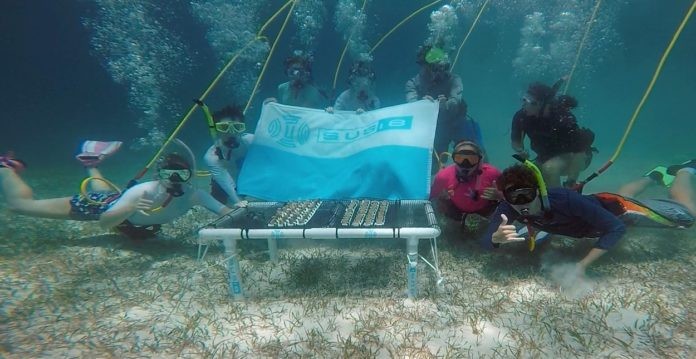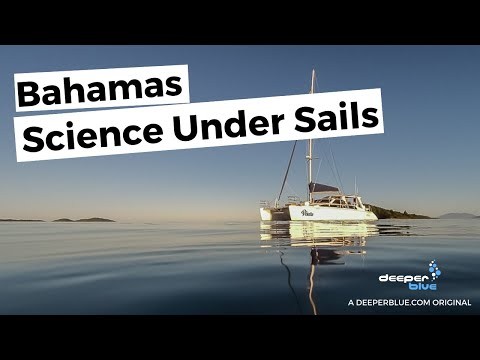My name is Mallory Morgan and I recently graduated from the Scripps Institution of Oceanography in San Diego, California where I studied marine biodiversity and conservation. This past July I joined the Science Under Sail Institute for Exploration (or SUSiE) as a SEAmbassador. The group was on the last week of their final leg of the 2015 Expedition studying coral reefs throughout the Exuma Cays, Bahamas. I myself have participated in a similar study abroad program in Fiji, and was eager to build on this experience and understand what SUSiE was doing differently. I was invited to come on-board and provide a policy and management perspective to compliment the hard science students were fully submersed in. I am passionate about solutions and proactive strategies, backed by science and hard data collected from expeditions such as SUSiE. As an AAUS scientific diver at my academic institution, and a PADI Instructor, I was eager to participate in a scientific expedition that incorporates sailing and self-discovery. SUSiE is clearly more than just a study abroad trip, and that’s what I hope to convey in this series of articles. As an ocean advocate, I am excited about the research Dr. Robin Smith of the Science Under Sail Institute is doing. His work contributes to our understanding of an environment changing at a rate we have never seen before. Although I am deeply concerned about the state of our oceans and their projectory, I am equally inspired by the youth who are dedicating their lives to joining the effort of protecting our blue planet. Here you will learn a bit about life aboard a science and sailing expedition, hookah diving for research, and the various studies being undertaken to address the 75% of threatened coral reefs worldwide.
You can check out my short video from the expedition below:
Welcome to this series of articles from my time with SUSiE – The SUSiE Chronicles!
You can read more, during the course of this week, by clicking here.
Exploration Science – Discovery for Tomorrow’s Ocean Leaders
“Equipped with our five senses, we explore the universe around us and call the endeavor science.” Edwin Powell Hubble
Exploration science is Science Under Sail Institute for Exploration’s (SUSiE) innovative platform for engaging collegiate students in marine science. It moves beyond the cold, drab, isolated campus laboratory experience and fully submerges one directly into the environment under study.
Exploration science transforms interest into passion, and learning into experience.
SUSiE is not your typical controlled science experiment. There is no Google or Internet readily available to consult. One must rely on their own creative power and limited resources. On a Science Under Sail Expedition, your laboratory is windy, salty, and highly variable. You are thirsty, hungry, itchy, and hot. However…
You master sailing and nautical navigation. You learn scientific field research methods in-situ from coral reef experts. You sleep under the stars in a hammock on a 50’ catamaran in the Exuma archipelago of the Bahamas. You form 8 new lifelong friendships with your “fellow labmates” through a bonding experience you will never forget.
With SUSiE, scientific research is evolving.
Students aboard the SUSiE Expedition 2015 have traveled from all over the United States and the Bahamas to learn about coral reefs. Although students vary in expertise and background, they are all driven to understand and resolve the plight of the blue planet. Through hands-on experiments and lectures from various scientists and professionals, these young students are preparing for a future in ocean leadership.
Research Objectives include: (from SUSiE’s website)
- Establish 20-30 permanent research stations for long-term monitoring
- Collect monitoring data using photo- & video survey techniques
- Install coral explant arrays for long-term experimental research projects
- Perform multi-year bleaching & recovery experiments
- Collect seasonal Biometric data on experimental coral explants
- Collect genetic samples for symbiont ecology research
- Coral reef restoration project in Elizabeth Harbour
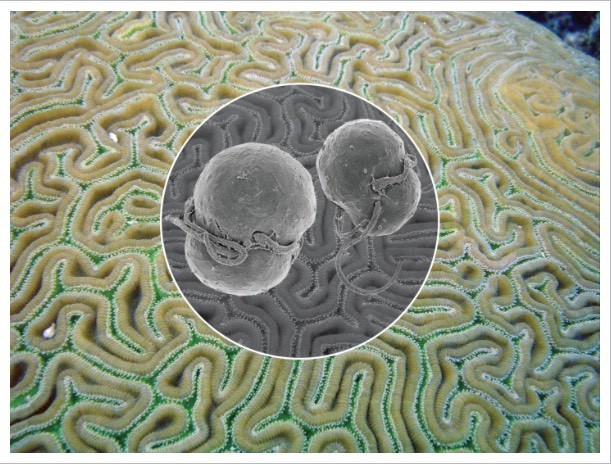
At the forefront of Science Under Sail’s research is founder and lead scientist of the expedition, Dr. Robin Smith. Dr. Smith has been studying a particular species of algae now occupying Caribbean corals in never before seen numbers, Symbiodinium trenchii (S. trenchii). Dr. Smith and SUSiE Fellows are part of a dynamic team researching this microscopic algae for the past decade around the globe. Similar to the pathogen causing the great Diadema (long-spined urchin) die off in the Caribbean, it is believed S. trenchii was introduced to the Caribbean via ballast water in ships transiting the Panama canal. Now understood as an invasive algae, careful attention and study is needed to monitor the effects of this ‘invasion’ over time. The research has led Dr. Smith to the Exuma Cays to understand the community shift occurring here in response to warmer waters and accelerated stress in the region.
Simply put, corals require symbiotic algae to perform photosynthesis and thus provide food to the coral. In turn, corals act as the host for the algae, giving it a protective space to live and providing nutrients for the algae. It is a delicate balance of give and take, a balance that is easily broken under stressful conditions.
At first it may seem as though S. trenchii has come to the Caribbean to do corals a favor. It tolerates higher temperatures and occupies stressed corals whose native algae has been ejected from its host (a process known as “bleaching”), seemingly unable to deal with increased sea-surface temperatures, pollution, and an ever increasing number of stressors from a rapidly growing human population. Some believe we should facilitate this shift, as S. trenchii seems to protect corals from bleaching when its native algae will not. However, Dr. Smith and his team have found S. trenchii actually hinders net coral growth and reduces the coral’s ability to produce calcium carbonate by up to 50%. Moreover, when conditions return to normal, S. trenchii can persist in corals for up to two years, greatly reducing the reef building capacity of those particular colonies. “If you are coral that’s not calcifying, you are essentially a jellyfish and you’re not building a reef”, says Smith. So, although this algae may appear to increase a coral’s chances of survival during warm water events, it outcompetes native algae over time and cripples coral reefs by reducing their reef building capacity. Continued research is needed, and SUSiE offers a unique platform to continue this cutting-edge work while engaging young marine scientists in the process. Several articles have been listed below for further discussion of this phenomenon including a 16 page comic on the SUSiE blog titled “REEF “.
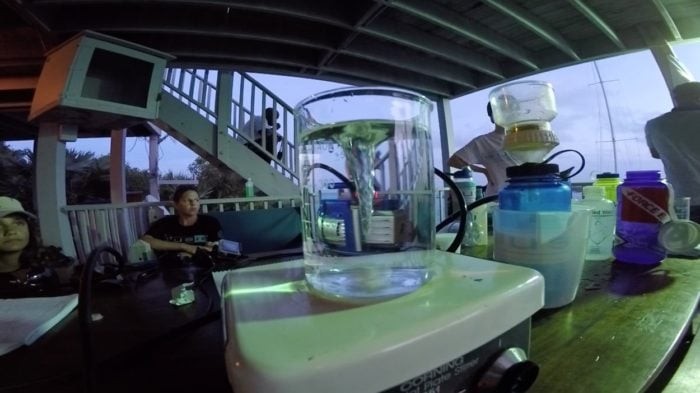
Also on SUSiE’s exploration science agenda this year is the investigation of micro-plastic pollution and corals. To investigate the potential affects of micro-plastics on coral calcification, Dr. Smith has unique micro-plastic beads manufactured, similar to those used in cosmetics and personal care products. The uniqueness of these beads was the fluorescent dye that was added, to facilitate recovery from the tissue of corals used in experiments. The experiment: to discover if corals are ingesting the plastic particles chronically filling our oceans, and if so, does this negatively affect corals’ ability to build reefs. Calcification rates are measured to understand how plastics may affect coral’s ability to grow in the future. Calcification refers to the deposit of calcium carbonate from the coral polyp, which builds the impressive hard skeleton we all associate with coral reefs. Without calcification, scleractinian (hard) corals cannot exist in the beautiful, colorful colonies we know and love.
Unfortunately, SUSiE’s experiment did indeed find coral to ingest the plastic micro-beads. This reinforces novel research published just months ago by researchers on the Great Barrier Reef who also found the corals to ingest plastic (see the paper here). The calcification measurements are currently being analyzed and will soon shed light on the affects that micro-plastics may have on coral reef formation in coming decades.
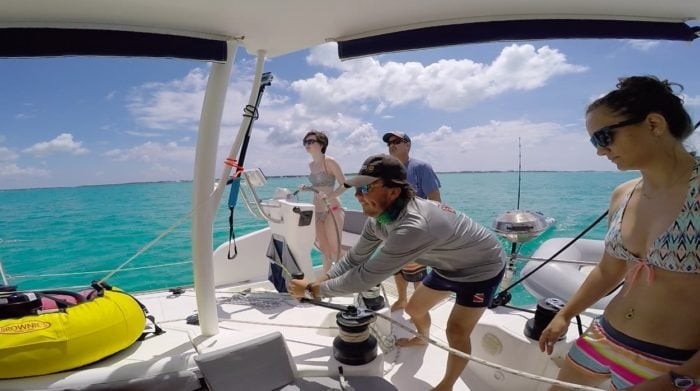
This was many of the students’ favorite experiment of the expedition as it was the most relatable to daily life. It was a unique experience for the students to visually witness the coral ingesting the fluorescently labeled plastic beads. Graduate student Morgan Knowles commented “usually we study algae and fish in relation to corals, so it’s nice to investigate another interaction”. This is very innovative research that SUSiE Fellows have the unique opportunity to participate in. It is clear to anyone who spends time in and on the water that plastic is plaguing our oceans. It is likely we will be seeing a lot more plastic research in the near future, as this is one of the most pressing problems our oceans and food chain face today.
Another project that SUSiE contributes to is an active coral restoration site caused by a vessel grounding at Fowl Cay in Elizabeth Harbour, Georgetown Bahamas. When a catamaran sailing in from France ran aground in 2013, following a ‘preferred route of entry’ into the Harbour on a commonly used digital chart (this has since been corrected), SUSiE was called by local Environmental activist, Catherine Booker of the Elizabeth Harbour Conservation Partnership (EHCP), to collaboratively put together a 5 year strategic plan for the site. SUSiE typically does not support coral restoration efforts, as most all-worldwide restoration projects focus on reefs degraded by ever present local, regional and global stressors. SUSiE believes that in most instances, until the stressors that killed the natural ecosystem are removed, planting hundreds to thousands of nursery reared corals will lead to the same outcome and is likewise a waste of valuable time and resources. However, it has been demonstrated that restoration efforts focused on acute incidents, such as a vessel grounding, can kickstart and accelerate the natural recovery process. As such, SUSiE found that they could get behind restoring a known healthy and thriving reef damaged by the vessel, and in this instance, implement a successful coral restoration project Fellows and the local Bahamian community could get behind. This summer was the second year the expedition returned to the restoration site located at Fowl Cay in Exuma. On one side of the channel between Fowl Cay and Guana Cay is a coral nursery established by SUSiE and EHCP. Here, coral fragments broken from the reef during the vessel grounding are attached to arrays and continue to grow by receiving nutrients from the swift waters of the adjacent channel. They have essentially been rescued and given a second chance, much like the more charismatic animals we know and love such as turtles and dolphins.
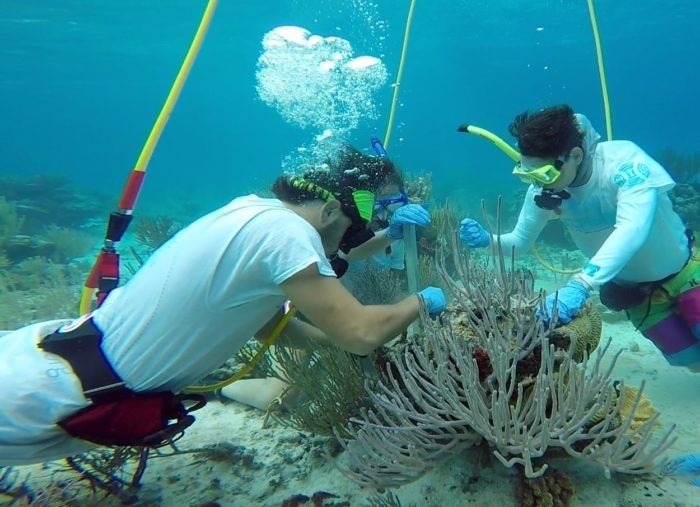
First, fragments are processed onboard the SUSiE catamaran by attaching the corals to limestone tiles with marine epoxy. They are then attached to underwater arrays secured in a seagrass bed, forming a coral nursery where they will grow for another year. Subsequent expeditions explant the fragments from the nursery across the channel onto damaged sections of the same reef they came from. Although not enough time has passed to deem this restoration significant by statistical measures, SUSiE is proud to report an approximately 80% survival rate from 2014-2015. By focusing restoration on the damaged area of an otherwise healthy, vibrant ecosystem, survivorship and success is likely. This experiment will continue with each expedition and contribute to the growing literature surrounding active coral restoration worldwide. . Akin to “underwater gardening,” says Jerah Coviello, SUSiE Co-Founder and COO, “visitors are encouraged to visit the nursery site and two dinghy moorings have been installed nearby to facilitate easy access.”
To supplement fieldwork, students are treated each night to a lecture from either Dr. Smith or a visiting SEAmbassador such as myself. Ms. Catherine Booker is a SEAmbassador from the Exuma Foundation and the nonprofit Community Conch, and EHCP. Ms. Booker visits the expedition often to talk with the students about local work being done to understand and manage conch populations in the Bahamas. She also assists in coral nursery fieldwork and gives interdisciplinary talks on stakeholder engagement and conflict resolution in marine conservation practice. Another SEAmbassador on my leg of the expedition was Dr. Christopher Perle from Florida State College at Jacksonville. Dr Perle is a pelagic fisheries scientist whose work he shared focuses on white sharks, manta rays, and the peculiar mola-mola sunfish.
I myself visited the expedition to convey policies and strategies currently being employed in coral reef management in Florida. My perspective offers climate change impacts on coral reefs and their dependent communities, and various adaptation measures that are successfully being implemented. I presented findings from my recent master’s capstone project investigating the status and degree of implementation of the Climate Change Action Plan for the Florida Reef System (View the report here). My objective was to offer solutions and encourage students to be proactive in stewardship of these natural places we tend to take for granted.
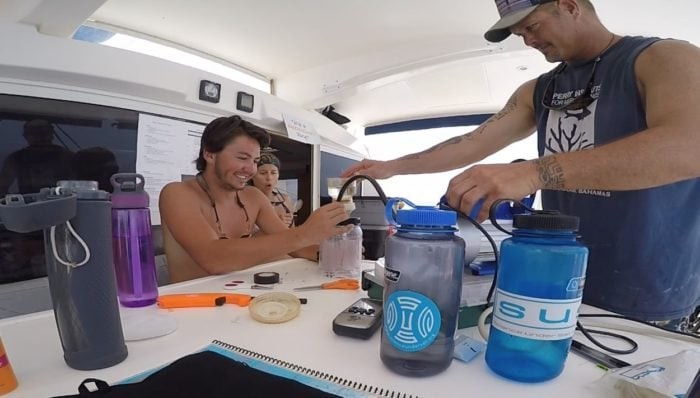
SUSiE understands the importance of the students’ awareness in understanding the translation of science into management and action. If we want our children and grandchildren to experience scuba diving in incredible places like we have been so fortunate to do so, we must understand how we impact them and how we can effectively manage them. In order to manage them we need sound science to understand what makes corals grow and flourish, and what degrades reefs and diminishes resilience for the future. Organizations such as SUSiE are taking an innovative, open format approach with exploration science.
On the last day of expedition I asked the students, “What is exploration science?”. Responses I received include “rolling with the punches”, “trial and error”, “being an explorer” and “having an urgent curiosity“. You travel to a place, you see what’s going on, and you investigate why. As SUSiE 2015 fellow Ashley Howell says, “You go deeper than the surface”.
To support SUSiE and their work, consider joining the SUSiE Society today at http://www.scienceundersail.org/thesusiesociety/.
If interested in learning more about the invasive algae discussed above, please reference:
- http://www.pnas.org/content/112/24/7513.abstract
- http://www.natureworldnews.com/articles/14973/20150602/coral-reefs-invasive-microbe-may-protect-them-but-at-a-cost.htm
- http://phenomena.nationalgeographic.com/2015/06/02/the-microbe-that-invaded-caribbean-coral-reefs/
- http://www.eurekalert.org/multimedia/pub/92588.php
- http://www.ieyenews.com/wordpress/coral-reef-health/
- http://www.scienceundersail.org/applications/sus-expedition-palau-reef-research/#more-1540
You can read more, during the course of this week, by clicking here.

